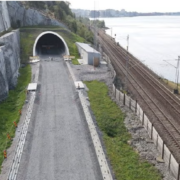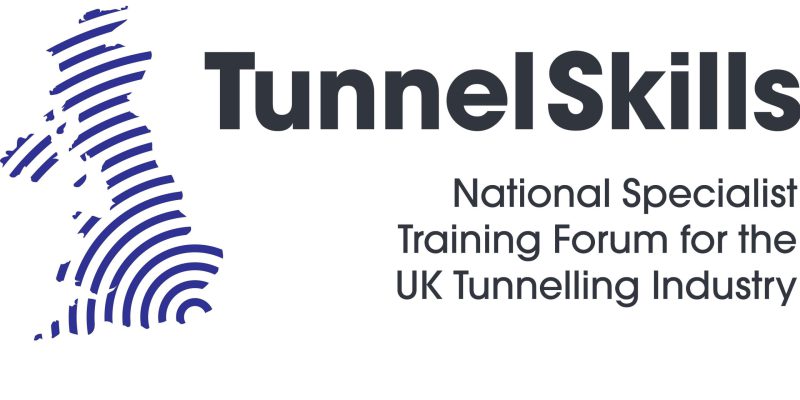
TunnelSkills – the national specialist training forum for the UK tunneling industry – specializes in the application of immersive learning and new technology to improve training, learning, and recruitment in the sector.
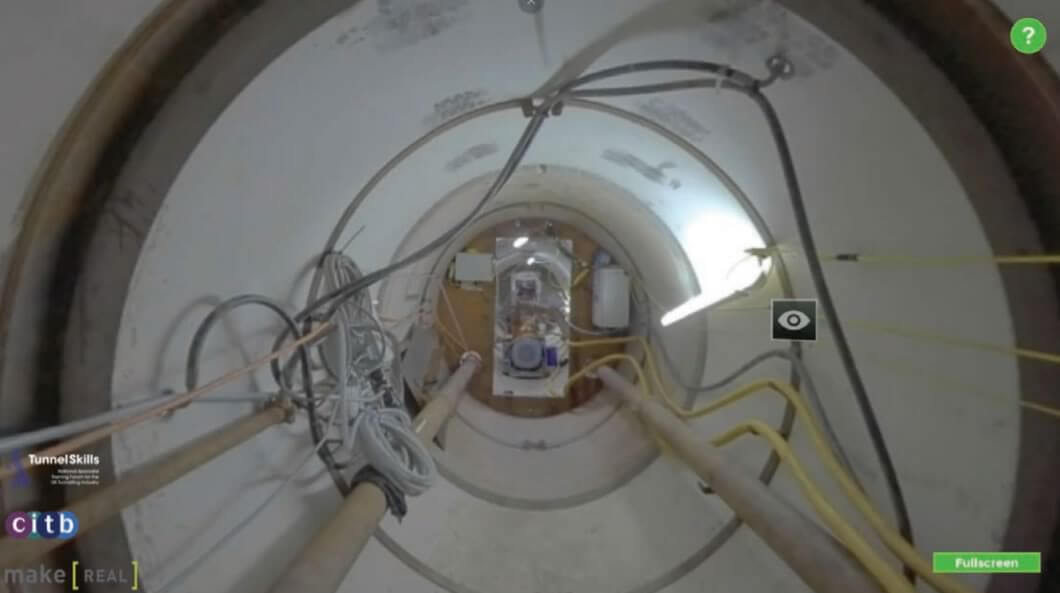
Preparing personnel for working below-ground in tunneling has always been a challenge for the industry. Exposing learners to training in a live and active work environment can be potentially hazardous. Immersive technology offers total engagement in a simulated environment for deeper understanding and better learning while removing the need to gain access.
In an increasingly modern world, we are seeing the ways in which technology can continually improve and streamline processes to be faster, safer, and smarter. Using immersive learning tools such as Virtual Reality (VR) and Augmented Reality (AR) for training is nothing new. Training for those in potentially hazardous professions such as maintenance crews on offshore oil rigs or airline pilots has included the use of new
technologies for many years. However, in recent years, there have been considerable advancements in technology and, more specifically, hardware. With the advancement of hardware such as the Oculus Quest virtual reality headset, for example, a full range of interactive motion became possible in what is known as 6DoF (six degrees of freedom). This enables the end-user to use both hands for interactions and have a full range of motion within a 360-degree virtual world.
Immersive learning is an experiential training methodology that uses virtual reality and augmented reality to simulate real-world scenarios and train employees in a safe and engaging immersive training environment. It combines a sense of presence with spatial design to improve effectiveness and user engagement, putting learners in an immersive, realistic environment where they can practice spotting hazards and make decisions that are safe. It provides an effective tool for influencing the safe behavior of team members in a scalable way.
A COLLABORATIVE PROJECT PARTNERSHIP LED BY TUNNELSKILLS
TunnelSkills is the National Specialist Training Forum for the Tunneling Industry. Formed in 2008, TunnelSkills’ primary objective is to benchmark safety and competence for all in the underground environment by promoting competence via on-site training and assessment leading to recognized accredited qualifications. As a membership-based organization representing and supporting its members across the UK tunneling sector, TunnelSkills was keen to explore the potential for immersive learning technology to enhance the quality of tunneling training.

In 2018, TunnelSkills came up with the idea of investigating the potential for bringing the benefits of immersive learning to the world of tunneling training. TunnelSkills formed a collaborative partnership including main contractors, with major projects such as Tideway and HS2, and with digital technology companies, Make Real, Pauley, and FULmax, to devise a project plan. This collaborative partnership consulted with the Construction Industry Training Board (CITB) and submitted a successful application to the CITB’s Flexible Fund.
Funding support was agreed, which enabled the project to commence in 2019. Tom Lane, Chair of TunnelSkills when the project was conceived, played a major role in seeing it through. He explains why the project is so important for the industry: “In tunneling, we’re dealing with environments which are hard to understand and visualize, especially when only using presentations, diagrams, or photographs. Immersive learning technologies have provided us with a game-changing opportunity to address the challenges of sufficiently simulating or recreating the tunneling environment for workers to develop the behaviors and competencies required to work in such environments.
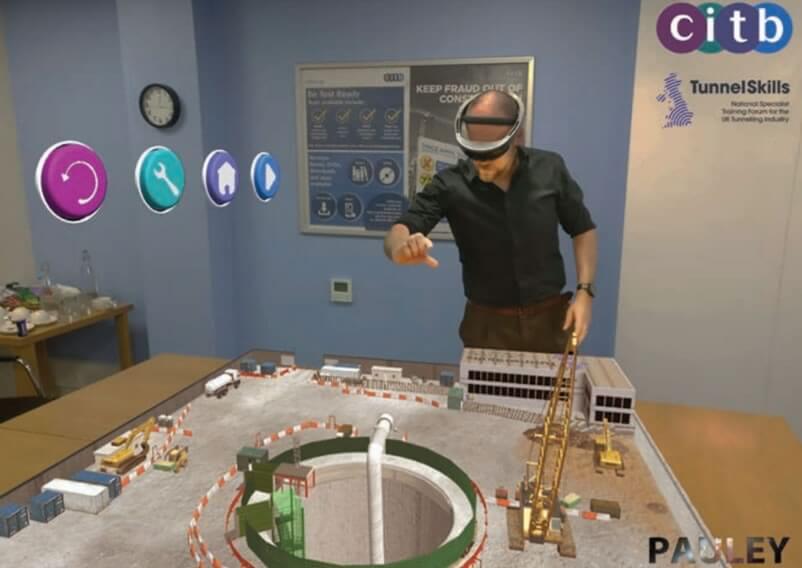
The resources we are developing will also give those looking at tunneling as a career a tangible, real-world. experience of being in a tunneling environment. The range of immersive assets in development will provide high-quality, freely-available resources to benefit the whole of the tunneling industry.” Lane then goes on to highlight the benefits and aims of the project, “These resources will give stakeholders a realistic, consistent and safe environment replicating tunneling environments and equipment. The aim is that these
resources will be embedded across a broad range of qualifications and courses associated with tunneling, delivered to a range of beneficiaries, and made freely available to the sector. Research shows that people learn much quicker by doing, and this immersive technology holds the attention for longer and embeds learning by promoting competence via on-site training and assessment leading to recognized accredited qualifications.
As a membership-based organization representing and supporting its members across the UK tunneling sector, TunnelSkills was keen to explore the potential for immersive learning technology to enhance the quality of tunneling training. In 2018, TunnelSkills came up with the idea of investigating the potential for bringing the benefits of immersive learning to the world of tunneling training. TunnelSkills formed a collaborative partnership including main contractors, with major projects much more effectively. It allows people to practice real-life scenarios, such as the safe evacuation procedure in the event of a fire in the tunnel.”
INNOVATIVE LEARNING RESOURCES DEVELOPED BY THE PROJECT
The TunnelSkills Immersive Learning Project utilizes a mix of VR and AR apps and scenarios across a range of immersive learning teaching resources; these include an interactive 360-degree film with a choice of a user interface ‘Explore’ mode or ‘Guided Tour’ mode, digital models, and an introduction to the past and present of tunneling with insights from professionals within the industry.
On the VR side, there are four VR applications. The apps were developed for the Oculus Quest; Quest and Quest 2 headsets, as well as the FULmax BIM CAVE. Two of the applications take the form of game-like interactive scenarios, while the other two offer more cinematic experiences. All four VR applications have the common goal of promoting awareness of tunneling environments, the hazards associated with them, and the health and safety considerations you need to be aware of when working underground.
Augmented reality (AR) layers virtual content, such as digital objects or information, onto a real-world image. As AR interacts with physical environments, factors such as lighting and surface detection integrate virtual and actual reality. The overlaid 3D information is a seamless, immersive integration into the real environment. It allows users to view perception of the real work where they could not normally have access due to safety, costs, time, and access restrictions. It allows for group-based learning and communication where it can foster interest and increase engagement. It enables free movement around environments and objects where it would not be possible in real life. It can be used to complement existing training activities.
The TunnelSkills Immersive Learning AR application is deployed through Microsoft Hololens hardware. The Microsoft HoloLens is a pair of mixed reality smart glasses comprising a head-mounted display that allows the user to place a hologram in the real world where they can view and interact with the hologram via the device.
The AR resources developed through the project include two interactive scenarios covering Safety in Tunneling and Tunnel Emergencies. The AR app was designed to promote awareness of tunneling environments, access arrangements, emergencies, and health and safety considerations when working above and below ground. A flavor of the AR resources can be seen in a case study on the Pauley website.
These AR and VR resources come with downloadable, tailored, user guides to support those embarking on their AR and VR experience. The user guides include brief hardware guides, a description of the scenarios, and support/help topics. There are also individual VR and AR ‘Frequently Asked Questions’ sections to further support users, available on the TunnelSkills website.
This includes advice on how the apps can be used and how to purchase and manage a larger fleet of headsets: for example, if an organization wishes to incorporate these resources into project inductions, company inductions, or industry behavioral safety training programs.
INCREASED RESOURCE VERSATILITY – OTHER WAYS TO EXPERIENCE VR AND AR RESOURCES
The original project plan included dissemination activities, including taking the headsets into workplaces to trial the prototype apps; working with training providers of industry-specific training to embed the apps into their programs, and taking headsets into schools and other educational settings. The Covid pandemic struck mid-way through the project’s two-year timeline. The subsequent concerns around touching and sharing of equipment, and the necessary close contact required to support those using the headsets meant that this approach had to be reviewed.
In re-thinking the dissemination and application of the resources, TunnelSkills worked with Make Real, the digital tech partner that developed the VR apps to find a solution. TunnelSkills is also linked with Fulcro, which is a multidisciplinary and interdisciplinary technical specialist in 3D technology for the design and build sector, to utilize its FULmax BIM CAVE technology which enables teams to stand inside VR at life-size without wearing head-mounted displays.
The VR apps have been enhanced to develop the original prototypes with a view to using the 360-degree videos in wider-ranging environments, rather than relying solely on the use of individual headsets. This involved the development of a ‘Guided Tour’ facility, using industry-approved commentary to add to the existing ‘User-Interface’ / ‘Explore’ capability. This guided-tour facility will be incorporated into the 360-degree video and enable the resulting video experiences to be used in the FULmax CUBE. The FULmax CUBE is an immersive, interactive, and collaborative virtual environment without the requirement for individual headsets so provides a Covid-safe way for teams and learners to interact with the TunnelSkills content and each other.
In addition, web-based versions of some of the AR and VR apps are available to access the resources via monitors or screens. Although the full immersive experience is limited by viewing on a two-dimensional screen, you can still interact with the content on-screen to appreciate the 360-degree environment. This method avoids the use of headsets and enables groups of learners and users to view in a collaborative and shared setting, thereby increasing the versatility of the resources. Two of the tunneling VR apps are available in web-based versions. Readers can view and interact with these versions (Apps 3 and 4) via the links on the VR Resources TunnelSkills webpage.
INDUSTRY RESPONSE TO RESOURCES AND FUTURE OF IMMERSIVE LEARNING IN TUNNELLING
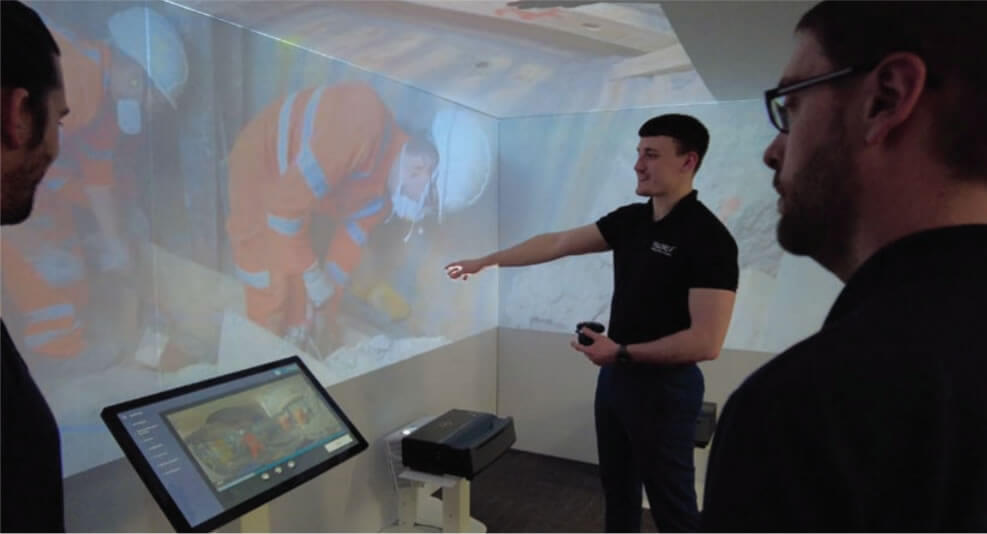
The resources developed by the project have been trailed by industry partners to provide evaluation and feedback. Gerry Keigher from Tunnelcraft states: “We used the headsets with several colleagues at Tunnelcraft – all seasoned tunneling professionals, and they expressed their surprise at the exceptional immersive experience. The emergency response scenario generated the most praise for its realism. The advancement of this technology is an exciting and beneficial step for our industry.” Tunnelcraft has decided to invest in its own fleet of headsets to incorporate the resources into its underground and tunneling training program.
Tunneling contractors on some of the largest current projects in the UK are starting to see the value in the use of these resources, using them not only with staff who may be unfamiliar with the below-ground tunneling environment but also within their work-experience programs. Local schools and future apprentices are being supported to get a taste for a career underground.
There is also the intention to incorporate the resources into the in-house delivery of tunnel safety and other training. Immersive learning provides remarkable capabilities for collaboration, training, learning, and sharing experiences as a team, despite the distance. In the construction sector, this capability is still in its infancy. There will be many companies that will be able to develop further VR and AR uses and content to meet their needs at the project, joint venture, or individual company levels. Neil Hancox, current Chair of TunnelSkills, is positive about the benefits for the tunneling industry: “This project is a fantastic springboard to embrace new technology within our sector to improve and progress. With this set of ready-made resources, organizations can make use of the materials to enhance their existing training and outreach activities, assess the value, and make informed decisions about how they can use these new technologies moving forward. In the three years since the conception and commencement of the TunnelSkills project, technology has continued to advance, and now with new cameras, headsets, and other hardware, this makes it increasingly cost-effective and efficient to create and showcase more and more immersive collateral. TunnelSkills is keen to engage with those interested in learning more and we can offer advice and support with the resources.”
FURTHER INFORMATION
Learn more about the resources via the TunnelSkills website here or email: fto@tunnelskills.org










